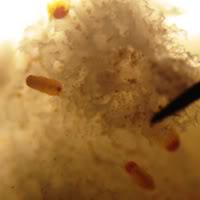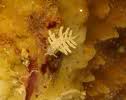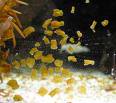I've heard several horror stories over the last few weeks of people buying tanks on craigslist and trading corals with others and receiving some nasty pests. So maybe this will help a little and please ad anything you feel may help out also. This hobby is expensive enough without loosing several corals to bugs. DIP YOUR CORALS!
Over the past decade, the marine aquarium hobby has enjoyed advancements in both technology and information regarding the captive care of live coral. As a result, many organizations and hobbyists have begun fragmenting and producing corals that are offered for sale in the marketplace, and traded among hobbyists. These corals, commonly referred to as "Frags," include a large number of SPS (Small Polyp Stony corals), LPS (Large Polyp Stony Corals), Soft Corals, Zoanthus Polyps and Mushrooms.
These species normally adapt very well to a captive environment, but unfortunately numerous pests and parasites have also reared their presence in home aquariums across the country. With the practice of swapping coral frags among hobbyists, club members, and the aquaculture facilities themselves, the presence of these pests in the US is increasing at an alarming rate.
Here's what every hobbyist needs to know about the identification and prevention of common "frag" who are pests finding their way into home reef aquariums
Acropora Red Bugs

Identification
One of the most recent "pests" that has now become prevalent is a very small crustacean that looks like a mite and appears to prefer most species of Acropora corals. This crustacean is yellow in color with a red dot, approximately 1/2 mm in length, and is very difficult to see without a magnifying glass. It has been theorized that red bugs are either a parasitic form of copepod or micro-amphipod, though very little research has been done and their true identification is not complete at this time.
Symptoms & Signs
It has been speculated that the crustacean feeds off of the slime and waste products produced by the Acroporas. If you have an established colony of Acropora sp. that begins losing coloration and stops showing normal polyp extension, take a closer look at the tissue of the coral for any small yellowish/red specks. It is oftentimes easiest to distinguish these pests on the shadowed underside of a branch. An infected colony of Acropora will typically show poor or no polyp extension, and will slowly lose coloration over time. As a result of this infestation, it has been found that the growth rate of the colony is seriously affected, and may even result in death to the coral itself.
It is not clear why these bugs prefer certain species of Acropora over others, nor is it clear why they are not found on other SPS corals such as Montipora, Pocillopora, or Seriatopora.
Treatment
Several methods of treatment - from introducing natural predators to medications - have been tested with various levels of success. Interceptor seems to be the prefered medication and best treatment for red bugs.
DIP ALL CORALS!!
Coral-Eating Nudibranch

Identification
Several species of nudibranch which feed upon Soft Corals like Sarcophyton sp. Leather corals, Xenia sp, Zoanthus sp., and Palythoa sp. polyps have made their way into the industry over the years. Most of the soft-coral-eating-nudibranchs can reach a size of 2 cm when full grown, and are best seen after the lights have been off on the aquarium for several hours. They often mimic the appearance of the coral they are preying upon, making them difficult to spot. Soft coral eating nudibranchs will slowly consume these corals causing bare spots or discoloration on some or all of the corals tissue.
A more recent nudibranch pest that affects SPS coral aquariums has recently become prevalent, and prefers to consume corals of the genus Montipora and Anacropora. These nudibranch are very small, attaining a maximum size only up to half of a centimeter, are pale white to tan in color, and have many branch-like appendages along their back. They are very damaging pests in a reef aquarium that can multiply and consume corals in a very short period of time.
Symptoms & Signs
Corals that become infected with these pests will begin to show white spots where the nudibranch have eaten away the tissue of the coral. The most vulnerable seem to be Montipora capricornis, also known as vase corals, as well as Montipora digitata, the branching form. Many times the nudibranch will begin feeding on the underside of the coral, and it will not become apparent to the hobbyist that the coral is being damaged until it can be seen in plain view on the top of the colony.
Treatment
Controlling outbreaks of these pests is difficult, and several different techniques are being experimented with. Removal of these pest is often performed manually with tweezers.
DIP ALL CORALS!!
The problem that exists with chemical dips is that it will only kill the nudibranchs that are on the colony and the rock that the coral is attached to when treated. This nudibranch has been found to lay eggs within the rockwork of the aquarium, as well as on other coral colonies. Therefore, just treating the colony and its associated rock will not solve the problem. One answer to this is to remove all colonies of Montipora and Anacropora to a separate containment system for a few months, and to repeatedly treat the corals and its associated rock with an iodine dip. This will ensure that the nudibranch within the display aquarium are eradicated due to starvation. Also, you will be able to monitor the health of the infected colonies with greater ease in the smaller system.
Flatworms

Identification
While Flatworms, also known as Planaria, can become a problem in just about any saltwater aquarium; the aquaculture industry has encountered two distinct types of flatworms that are now fairly common in the United States.
Rust Brown Flatworm
The first and most common type of flatworm can become a nuisance quickly in the home aquarium. These organisms are tan, brown or rust colored with a red dot, and reach a size of up to 1/4" in length. They are oval and slightly elongated with two tail-like appendages at their posterior. This brown flatworm has been identified as Convolutriloba retrogemma, and will proliferate rapidly in aquariums with elevated nutrient levels. The populations of these pests can increase to a point where they will actually perch on corals, and block the light from reaching the corals' tissue. Some experts believe that the flatworms actually feed on the zooxanthellae from coral tissue, thus damaging the corals themselves.
The Acropora Flatworm is starting to become prevalent in the United States, and has been recognized in Germany for the last few years. This unidentified species is a more aggressive species of flatworm that consumes the actual tissue of Acropora sp. corals at a rapid rate. This flatworm is white to opaque in color, and is mostly oval in shape, making them very difficult to notice in the display aquarium. They seem to prefer species of Acropora that have shorter polyps, and are most commonly found on Staghorn types and Tricolor species. This flatworm is very invasive, and immediate action should be taken if noticed in your aquarium
Symptoms & Signs
The Rust Brown Flatworm can be seen on top of corals, and normally in areas of low flow in the reef aquarium. The Acropora-Eating Flatworm can be recognized by the rapid tissue loss in certain colonies of Acropora, and their presence will be known by the gold to brown egg masses that they leave behind on the bare coral skeletons.
Over the past decade, the marine aquarium hobby has enjoyed advancements in both technology and information regarding the captive care of live coral. As a result, many organizations and hobbyists have begun fragmenting and producing corals that are offered for sale in the marketplace, and traded among hobbyists. These corals, commonly referred to as "Frags," include a large number of SPS (Small Polyp Stony corals), LPS (Large Polyp Stony Corals), Soft Corals, Zoanthus Polyps and Mushrooms.
These species normally adapt very well to a captive environment, but unfortunately numerous pests and parasites have also reared their presence in home aquariums across the country. With the practice of swapping coral frags among hobbyists, club members, and the aquaculture facilities themselves, the presence of these pests in the US is increasing at an alarming rate.
Here's what every hobbyist needs to know about the identification and prevention of common "frag" who are pests finding their way into home reef aquariums
Acropora Red Bugs

Identification
One of the most recent "pests" that has now become prevalent is a very small crustacean that looks like a mite and appears to prefer most species of Acropora corals. This crustacean is yellow in color with a red dot, approximately 1/2 mm in length, and is very difficult to see without a magnifying glass. It has been theorized that red bugs are either a parasitic form of copepod or micro-amphipod, though very little research has been done and their true identification is not complete at this time.
Symptoms & Signs
It has been speculated that the crustacean feeds off of the slime and waste products produced by the Acroporas. If you have an established colony of Acropora sp. that begins losing coloration and stops showing normal polyp extension, take a closer look at the tissue of the coral for any small yellowish/red specks. It is oftentimes easiest to distinguish these pests on the shadowed underside of a branch. An infected colony of Acropora will typically show poor or no polyp extension, and will slowly lose coloration over time. As a result of this infestation, it has been found that the growth rate of the colony is seriously affected, and may even result in death to the coral itself.
It is not clear why these bugs prefer certain species of Acropora over others, nor is it clear why they are not found on other SPS corals such as Montipora, Pocillopora, or Seriatopora.
Treatment
Several methods of treatment - from introducing natural predators to medications - have been tested with various levels of success. Interceptor seems to be the prefered medication and best treatment for red bugs.
DIP ALL CORALS!!
Coral-Eating Nudibranch

Identification
Several species of nudibranch which feed upon Soft Corals like Sarcophyton sp. Leather corals, Xenia sp, Zoanthus sp., and Palythoa sp. polyps have made their way into the industry over the years. Most of the soft-coral-eating-nudibranchs can reach a size of 2 cm when full grown, and are best seen after the lights have been off on the aquarium for several hours. They often mimic the appearance of the coral they are preying upon, making them difficult to spot. Soft coral eating nudibranchs will slowly consume these corals causing bare spots or discoloration on some or all of the corals tissue.
A more recent nudibranch pest that affects SPS coral aquariums has recently become prevalent, and prefers to consume corals of the genus Montipora and Anacropora. These nudibranch are very small, attaining a maximum size only up to half of a centimeter, are pale white to tan in color, and have many branch-like appendages along their back. They are very damaging pests in a reef aquarium that can multiply and consume corals in a very short period of time.
Symptoms & Signs
Corals that become infected with these pests will begin to show white spots where the nudibranch have eaten away the tissue of the coral. The most vulnerable seem to be Montipora capricornis, also known as vase corals, as well as Montipora digitata, the branching form. Many times the nudibranch will begin feeding on the underside of the coral, and it will not become apparent to the hobbyist that the coral is being damaged until it can be seen in plain view on the top of the colony.
Treatment
Controlling outbreaks of these pests is difficult, and several different techniques are being experimented with. Removal of these pest is often performed manually with tweezers.
DIP ALL CORALS!!
The problem that exists with chemical dips is that it will only kill the nudibranchs that are on the colony and the rock that the coral is attached to when treated. This nudibranch has been found to lay eggs within the rockwork of the aquarium, as well as on other coral colonies. Therefore, just treating the colony and its associated rock will not solve the problem. One answer to this is to remove all colonies of Montipora and Anacropora to a separate containment system for a few months, and to repeatedly treat the corals and its associated rock with an iodine dip. This will ensure that the nudibranch within the display aquarium are eradicated due to starvation. Also, you will be able to monitor the health of the infected colonies with greater ease in the smaller system.
Flatworms

Identification
While Flatworms, also known as Planaria, can become a problem in just about any saltwater aquarium; the aquaculture industry has encountered two distinct types of flatworms that are now fairly common in the United States.
Rust Brown Flatworm
The first and most common type of flatworm can become a nuisance quickly in the home aquarium. These organisms are tan, brown or rust colored with a red dot, and reach a size of up to 1/4" in length. They are oval and slightly elongated with two tail-like appendages at their posterior. This brown flatworm has been identified as Convolutriloba retrogemma, and will proliferate rapidly in aquariums with elevated nutrient levels. The populations of these pests can increase to a point where they will actually perch on corals, and block the light from reaching the corals' tissue. Some experts believe that the flatworms actually feed on the zooxanthellae from coral tissue, thus damaging the corals themselves.
The Acropora Flatworm is starting to become prevalent in the United States, and has been recognized in Germany for the last few years. This unidentified species is a more aggressive species of flatworm that consumes the actual tissue of Acropora sp. corals at a rapid rate. This flatworm is white to opaque in color, and is mostly oval in shape, making them very difficult to notice in the display aquarium. They seem to prefer species of Acropora that have shorter polyps, and are most commonly found on Staghorn types and Tricolor species. This flatworm is very invasive, and immediate action should be taken if noticed in your aquarium
Symptoms & Signs
The Rust Brown Flatworm can be seen on top of corals, and normally in areas of low flow in the reef aquarium. The Acropora-Eating Flatworm can be recognized by the rapid tissue loss in certain colonies of Acropora, and their presence will be known by the gold to brown egg masses that they leave behind on the bare coral skeletons.















